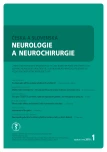The pilot study of effect of outpatient functional electrical stimulation of peroneal nerve
Authors:
J. Jeníček 1,2; Z. Drábová 1; M. Janatová 1,3; M. Vítězník 3; O. Švestková 1
Authors‘ workplace:
Klinika rehabilitačního lékařství 1. LF UK a VFN v Praze
1; Fakulta tělesné výchovy a sportu, UK v Praze
2; Společné pracoviště biomedicínského inženýrství FBMI ČVUT a 1. LF UK, Praha
3
Published in:
Cesk Slov Neurol N 2018; 81(1): 81-85
Category:
Short Communication
doi:
https://doi.org/10.14735/amcsnn201881
Overview
Aim:
The aim of this pilot study was to verify therapeutical effect of periodical functional electrical stimulation of peroneal nerve during 4 weeks of intensive outpatient therapy on speed and performance of gait in post-stroke patients, suffering from spastic leg paresis.
Methods:
14 subjects were enrolled into this pilot study (10 male, 4 female), aged 54,4 ± 9,4. The subjects were selected from patients suffering from chronic phase of stroke, spactic leg paresis and drop foot syndrome. Functional electrical stimulation was performed in total for 4 weeks (5 days weekly) as intensive ambulatory gait training with WalkAide neurostimulator. Emory Functional Ambulation Profile and Two Minute Walk Test were performed for evaluation of changes in speed of gait on different terrains and changes in the walking performance, respectively.
Results:
In this pilot study, average improvement of Emory Functional Ambulation Profile score of 11% was observed as well as average improvement of Two Minute Walk Test of 9%.
Conclusion:
Positive therapeutic effect of periodical ambulatory functional electrical stimulation of peroneal nerve on gait speed and gait performance in post-stroke patients was observed in this limited pilot study. Further research, including randomized controlled study featuring larger data sample, is needed to show significant evidence of the observed effect.
Key words:
functional electrical stimulation – stroke – spastic paresis – neurorehabilitation
The authors declare they have no potential conflicts of interest concerning drugs, products, or services used in the study.
The Editorial Board declares that the manuscript met the ICMJE “uniform requirements” for biomedical papers.
Chinese summary - 摘要
门诊功能性电刺激腓总神经效果的初步研究目标:
这项研究的初步目的是评估在强化门诊治疗4周期间,对患有痉挛性腿部轻瘫的中风后患者速度和步态的表现进行周期性功能性电刺激的效果。
方法:
14名受试者参加了这项试点研究(10名男性,4名女性),年龄为54.4±9.4岁。 这些受试者选自慢性中风期,痉挛性腿部轻瘫和跌脚综合症的患者。 使用WalkAide神经刺激器进行功能性电刺激总共4周(每周5天)作为强化步态训练。 Emory功能性步行剖面和两分钟步行测试分别用于评估不同地形上的步态速度变化和步行性能变化。
结果:
在这项初步研究中,观察到Emory功能性行走模式评分平均改善11%,以及两分钟步行测试平均改善9%。
结论:
在这项有限的试点研究中观察到周期性步态功能性电刺激腓神经对步行速度和卒中后患者步态表现的积极治疗作用。 需要进一步包括以更大数据样本为特征的随机对照的研究,以展示观察到的效应的重要证据。
关键词:
功能性电刺激 - 中风 - 痉挛性麻痹 - 神经修复
Sources
1. Sedova P, Brown RD, Zvolsky M et al. Incidence of hospitalized stroke in the Czech Republic: The national registry of hospitalized patients. J Stroke Cerebrovasc Dis 2017; 26(5): 979– 986. doi: 10.1016/ j.jstrokecerebrovasdis.2016.11.006.
2. Sabut SK, Sikdar C, Kumar R et al. Functional electrical stimulation of dorsiflexor muscle: effects on dorsiflexor strength, plantarflexor spasticity, and motor recovery in stroke patients. Neuro Rehabilitation 2011; 29(4): 393– 400. doi: 10.3233/ NRE-2011-0717.
3. Nolan KJ, Yarossi M, Mclaughlin P. Changes in center of pressure displacement with the use of a foot drop stimulator in individuals with stroke. Clin Biomech 2015; 30(7): 755– 761. doi: 10.1016/ j.clinbiomech.2015.03.016.
4. Cakar E, Durmus O, Tekin L et al. The ankle-foot orthosis improves balance and reduces fall risk of chronic spastic hemipatretic patients. Eur J Phys Rehabil Med 2010; 46(3): 363– 368.
5. Cameron M. The walkaide functional electrical stimulation system – a novel therapeutic approach for foot drop in central nervous system disorders. European Neurological Review 2010; 5(2): 18– 20. doi: 10.17925/ ENR.2010.05.02.18.
6. Lairamore CH, Garrison MK, Bourgeon L. Effects of functional electrical stimulation on gait recovery post-neurological injury during inpatient rehabilitation. Percept Mot Skills 2014; 119(2): 591– 608. doi: 10.2466/ 15.25.PMS.119c19z5.
7. Bethoux F, Rogers HL, Nolan KJ et al. The effects of peroneal nerve functional electrical stimulation versus ankle-foot orthosis in patients with chronic stroke: a randomized controlled trial. Neurorehabilitation Neural Repair 2014; 28(7): 688– 697. doi: 10.1177/ 1545968314521007.
8. Everaert DG, Thompson AK, Chong SL et al. Does functional electrical stimulation for foot drop strengthen corticospinal connections? Neurorehabilitation Neural Repair 2010; 24(2): 168– 177. doi: 10.1177/ 1545968309349939.
9. Meimoun M, Bayle N, Baude M et al. Intensity in the neurorehabilitation of spastic paresis. Rev Neurol 2015; 171(2): 130– 140. doi: 10.1016/ j.neurol.2014.09.011.
10. Wolf SL, Catlin PA, Gage K et al. Establishing the reliability and validity of measurements of walking time using the Emory Functional Ambulation Profile. Phys Ther 1999; 79(12): 1122– 1133.
11. Kafri M, Laufer Y. Therapeutic effects of functional electrical stimulation on gait in individuals post-stroke. Ann Biomed Eng 2015; 43(2): 451– 466. doi: 10.1007/ s10439-014-1148-8.
12. Swigchem R, Duijnhoven HJ, Boer J et al. Effect of peroneal electrical stimulation versus an ankle-foot orthosis on obstacle avoidance ability in people with stroke-related foot drop. Phys Ther 2012; 92(3): 398– 406. doi: 10.2522/ ptj.20100405.
13. Wilkie KM, Shiels JE, Bulley C et al. Functional elec-trical stimulation impacted on important aspects of my life – a qualitative exploration of chronic stroke patients perceptions of FES. Physiother Theory Pract 2012; 28(1): 1– 9. doi: 10.3109/ 09593985.2011.563775.
14. Kluding PM, Dunning K, O’Dell MW et al. Foot drop stimulation versus ankle foot orthosis after stroke, 30-week outcomes. Stroke 2013; 44(6): 1660– 1669. doi: 10.1161/ STROKEAHA.111.000334.
Labels
Paediatric neurology Neurosurgery NeurologyArticle was published in
Czech and Slovak Neurology and Neurosurgery

2018 Issue 1
Most read in this issue
- A neurological view on spondylodiscitis
- Parosmia and phantosmia in patients with olfactory dysfunction
- Assessment of cognitive functions using short repeatable neuropsychological batteries
- Cavernous sinus thrombosis – still occurring complication of rhinosinusitis
